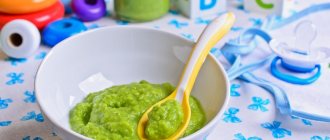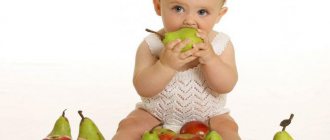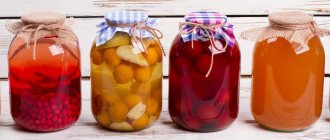If even at one year old a child could be fed single-ingredient and most gentle soups and porridges, then at one year and two months the situation changes dramatically. Now the toddler’s menu largely replicates the diet of the rest of the family. The main thing is to pay increased attention to the processing of components.
While many adult dishes are already available to the baby, only if a number of features are observed will they not harm the growing body and provide it with noticeable benefits. The basic rule of the period is the use of traditional components for the family, season and area. After all, it is at this age that a child develops taste preferences and a love for specific foods.
Features of preparing dishes for children after one year
For a child who recently turned one year old, the optimal approach is based on compliance with the following rules:
- The texture of the dishes should continue to resemble puree, but no longer homogeneous, but with small lumps.
- The established diet must be followed. If the baby receives food at the same time every day, this will ensure timely production of enzymes in the required volume. As a result, the digestion process will proceed clearly and without failures in the form of dyspeptic disorders.
Tip: It is strictly forbidden to feed your baby from your own plate, even if the dish is the same. Children at one year and a couple of months do not yet have a strong enough immune system to fight the viruses and bacteria of those around them. Mothers who practice such feeding are often forced to treat their children for colds and intestinal infections.
- When creating a feeding schedule for your child, you need to remember that in just a year or two he can go to kindergarten. It will be good if this fact does not require changing the established routine.
- It is recommended to feed a baby at this age 4-5 times a day, and at one time he should consume no more than 200 ml of food (this volume corresponds to the volume of a child’s stomach).
- Breast milk is often included in the diet of a baby who has just turned one year old. It is important to remember that consuming this product is a meal in itself, so you should not use the nutritional mass as a snack. It is better to use it to feed the baby in the morning or evening, otherwise you can spoil the baby’s appetite.
- The menu for bottle-fed children involves the continued use of adapted formulas during awakening and before going to bed. They can be gradually removed from the diet, replacing them with baby yogurt or kefir.
By following these simple rules, you can count on a smooth transition for your baby from his usual foods to “adult” dishes.
Multigrain porridges in complementary foods
Table of contents:
I forgot to describe multi-grain porridge in that article. It’s hard to imagine complementary feeding without them. What is multigrain porridge in the understanding of complementary feeding? This is a combination of 2 or more grains. Now you can buy many different cereals: 4 grains, 5 grains, etc. Basically, they are quick-cooking, about 5-10 minutes with boiling water and everything is ready, but it is better to cook.
The first acquaintance with multigrain porridges occurs after the introduction of 2 cereals. For example, rice and buckwheat were introduced into complementary foods. Now you can combine them and offer them to your baby as a multigrain porridge. The question may just arise: Will the child like this combination? Let's experiment!
Although I believe that it is best to introduce a porridge mix to a baby after introducing 3-4 cereals into complementary foods, it seems that the baby is more ready to digest such food and 3-4 cereals are more related to multi-grain porridges than 2 cereals. The approximate age of 8-10 months for introducing multi-grain porridge into complementary foods.
My child became acquainted with oatmeal late, almost a year old, so a mixture of 3-4 grains began to be given too late. Since the cereals are all included in complementary foods, there should be no reaction, unless the manufacturer added something unfamiliar. If the porridge is cooked from regular cereal, then there should be no problems with introducing multi-grain porridge; you can even limit yourself to 2-3 days of waiting.
How to properly plan a baby's diet?
After children turn one year old, their menu expands significantly with new ingredients. Parents should ensure that the baby's diet is varied and complete. It must necessarily include the following food products:
- Vegetables. Now the little one can eat them boiled, stewed and raw. Zucchini, light pumpkin, beets, broccoli, cauliflower, potatoes and carrots form the basis of the diet. They are used to make purees, soups and casseroles. The child can already be fed from the same pan with the rest of the family, but only if the broth was made from boneless meat (otherwise the first broth must be drained).
- Fruits and berries. These must be fruits traditional for a particular region. Additionally, it is allowed to include blueberries, bananas, and plums in the menu.
- Porridge. For children over one year old, these dishes can be the best option for breakfast or afternoon snack. In order to diversify the diet, they can be offered to the child as dinner. Cereals need to be constantly alternated. Buckwheat, corn, oatmeal and rice are considered optimal at such a tender age. It is better to refuse semolina and pearl barley for now.
- Protein. It has increased nutritional value for young children, because... saturates fabrics with building material. The baby's diet should consist of regular consumption of fish (twice a week), and on the remaining days we evenly distribute meat and legumes. There are a lot of proteins in milk and fermented milk products.
- Fats. Contrary to popular belief, this macronutrient should be present in the child’s menu at one year and two months, the main thing is that the fats are correct. The optimal source of the substance will be sour cream, vegetable oil and butter.
At such a tender age, products with a large number of aromatic herbs and fragrant spices are strictly prohibited. To enhance the taste, for now you can only use basil, dill, parsley, and rarely cinnamon. Products that contain artificial ingredients will cause the child to become addicted and refuse natural food, so any semi-finished products are prohibited.
Beetroot and tomato in complementary foods
Over the past week, I introduced my baby to borscht (my goal is to switch to a common table). Yes, not separately with beets and tomatoes, but with both products at once. I decided to keep it simple and cooked borscht with beef and offered the baby a couple of spoons, mostly potatoes and cabbage. So in 4 days I introduced borscht into complementary foods. To say that beets or tomatoes are included in a child’s complementary foods, no, I don’t agree. Because borscht contains a minimum concentration of beets and tomatoes. Borscht for a child is cooked simply, without parsnips, bay leaves, black pepper, and other similar additives that make borscht a tasty and unique family dish, but these are the ingredients that can lead to an allergic reaction. They should be gradually added to the borscht, one ingredient at a time, and the baby should be introduced to them.
Anyway, a little later I will cook the beets and introduce them over 3-5 days, I will watch the baby’s reaction. But tomato can be added to other dishes in small quantities now. In the summer you can introduce fresh tomato, the baby will be about 1 year and 4 months old, I think the normal age for introducing fresh tomato.
When I write a tomato, these are homemade tomatoes that were rolled into jars in the summer without additives or preservatives; I simply boil them and roll them up. I've had these jars for exactly a year. My husband drinks this tomato as tomato juice, and I use it to prepare borscht and other dishes that require tomato.
Rules for developing a menu for every day
When planning your meal schedule, it is recommended to follow certain rules. This will help normalize digestion and ensure uniform saturation of the child’s body with all the necessary components and substances:
- Porridge, meat, fish, cottage cheese, eggs, and vegetables are ideal for breakfast. Milk, herbal teas, and fruit drinks can be used as liquid supplements.
- Lunch should include soup with meat or vegetable broth and a second course (meat or fish with a side dish). After the baby turns one year old, dessert is allowed in the form of soufflé, mousse, fruit, compote or fruit drink.
- Salad as a snack is usually introduced no earlier than one and a half years.
- An afternoon snack can be a liquid milk or fermented milk dish with cookies or fruit.
- Children should receive the maximum portion of their daily protein intake in the morning, for breakfast and lunch.
- Dinner can be the same type as breakfast, but without excessive amounts of protein.
- Each child's feeding should include at least one hot dish.
When thinking about food for a child, we must not forget about his drinking regime. It is not necessary to limit your baby to clean water. At the age of one year, children can already be given various decoctions, special teas and compotes. Each meal should end with drinking liquid.
Chicken in feeding
The last product we are familiar with at the moment is chicken fillet. It all turned out strange. I planned my first acquaintance with chicken in soup, using secondary broth. But in the end I made tender chicken cutlets, which the child looked at very expressively and demandingly at the same time. As a result, I introduced a small piece of chicken fillet into complementary foods for 4 days, since at the end of 4 days I ate one cutlet.
My cutlet recipe is simple: chicken fillet, onion, raw potatoes, dry bread, water, chicken egg. Approximately weight is about 1 kg. Small cutlets, approximately 50-60 grams each. I don't like big cutlets. Chicken cutlets were lightly fried in vegetable oil and then stewed over low heat.
No reaction was observed, the introduction of the cutlets was successful. Again, I can’t say that I will give about 50 grams of chicken fillet at once, just a small piece at a time, but you can safely cook the soup using recycled chicken broth. There shouldn't be a reaction. Let me remind you that modern chicken meat is dangerous not only because of the proteins, but also because of the antibiotics that are fed to the chicken for active growth. Chicken is introduced into complementary feeding after 12 months, usually after a quail or chicken egg, but this time everything is different for me.
About success in complementary feeding!!!
No matter how hard you try, monitoring your child 24 hours is not possible. Sometimes you have to trust close people with your most precious thing - a small baby who strives to grab something and eat it, especially if food interest is in full swing. Therefore, the most important rule , no more important, and probably never will be, is to teach your loved ones and people responsible for the child to feed the baby either only categorically with the mother’s permission or to give microdoses of new foods, not a piece more or less. Even if the baby asks for more.
I'll explain. My husband has already learned that he can only give the child what I gave and put it on the table for the child. Everything else he can give is only a small crumb. A crumb of bread, one pasta, one potato, of course from his plate and preferably before he starts to eat. The husband can also give an apple or a banana, everything else is prohibited. The same rules apply to other family members. No matter how the child asks, he cannot be given more. True, it’s impossible to train my husband to inform me about this baby later, I find out everything in hindsight, eh!
The second important rule is to vacuum/rag/clean twice a day, since everything on the floor goes straight into your mouth.
The third rule is to place plates, mugs, spoons and knives only in the middle of the table, nothing on the edge, or next to it, or in the reach of small hands, especially if the plate is full, or a mug with a hot drink. If the child is sitting in your arms, all devices are placed a little forward and to the right if the child is right-handed, and, conversely, out of the reach of the little person.
In any case, the child will independently study the world, adults will help him study it, the mother’s task is to provide all possible options for this study and protect the life and nutrition of the baby. Of course, you can’t foresee everything, but you can try, talk with family members, only a mother can predict the actions of loved ones.
And yes, you can only agree with very close family members, who often stay and look after the child instead of the mother, and not leave the child alone with all other relatives (jokers and helpers), in order to avoid introducing the baby to new foods.
We are not afraid and add me to Odnoklassniki and Instagram!
Did you like the article? Subscribe to site updates
"Encyclopedia of Baby Food"!
Don't forget to bookmark us! (CTRL+SHiFT+D) Subscribe to the site, comment, share on social networks.
On our website Encyclopedia Baby Food there is useful information on the nutrition of your children, which is useful for everyone, and we update the Encyclopedia Baby Food website constantly and try to search and write only excellent, verified and necessary information for you and your children.
Disclaimer #1: It is necessary to understand that the author of the articles on the Encyclopedia Baby Food website is not a medical professional, “I am not a doctor.” The information I share is based on my own experience. My goal is not to teach you how to eat or feed your child, but to tell you about what we did, what new things I learned or read. This allows you to expand your knowledge about baby food, allows you to see the whole process so that you can decide whether you like it or whether it’s worth doing the same.
Disclaimer #2 : However, the above does not replace visiting your pediatrician. Before you start complementary feeding, you should seek his professional opinion on the best way to introduce new foods to your baby. Please also note that you need to look at the original date of published articles, as some “best practices” may have changed. Always consult your child's pediatrician about complementary feeding and his or her health.
Disclaimer #3: Keep in mind that every family is unique, and every situation is completely unique. There are no universal solutions. Only you can find what works best for you. Certain goals require certain sacrifices and priorities—not everyone wants to make those choices, and that's GREAT! Just know what you want to achieve and be ready to get to work doing your best!
Disclaimer No. 4: The Encyclopedia Baby Food website uses photos from books on baby food with attribution for a more complete understanding of the information (Article 1274, paragraph 1, part four of the Civil Code of the Russian Federation). Literature on baby nutrition was found freely available on the Internet.
Apricot puree with chicken Banana-apple puree Banana puree Borscht Broth with peas and rice Kohlrabi sandwich Zucchini jam with strawberries Buckwheat with green peas Buckwheat porridge Buckwheat porridge with apricots Buckwheat porridge with banana Buckwheat pilaf Children's vinaigrette Children's ketchup Children's cucumber salad Children's salad Olivier Baby puree of strawberries, banana, yellow cherries, matsoni and cookies with cereals Baby puree with cottage cheese and fruit Homemade pizza Breakfast outside Baking cauliflower Baked carrots Baked carrots and cherries with millet Cabbage with white beans Mashed potatoes Quinoa and pumpkin porridge Porridge Quinoa porridge for breakfast Quinoa and apple Strawberry puree Strawberry puree with banana Strawberry compote Compote of wild apples and raspberries Compote of dried fruits steamed in a thermos for a child over 8 months Corn porridge Corn porridge with pear Corn porridge with pumpkin Corn porridge with pumpkin and carrots Corn porridge with apple and carrots Chicken cutlets with carrots Chicken with carrots, sweet peppers and potatoes Navy pasta Pasta with orange sauce Carrot and potato puree Carrot and rice casserole Carrots with chicken Amanita from eggs and tomatoes Vegetable puree from cauliflower and carrots Vegetable soup with corn semolina Vegetable soup with cheese and corn semolina Vegetable cream soup with bell pepper Oatmeal Pancakes with hot kefir Omelette in a bag Omelette pancake Peach puree Zucchini and carrot pie Zucchini pie White cabbage pizza Rabbit pilaf Chicken pilaf with green peas and corn Banana and cherry puree Banana, cottage cheese and porridge puree 4 grains Broccoli (cauliflower) puree Broccoli, zucchini and cauliflower puree Blueberry puree Pear puree Pear and banana puree Pear and pumpkin puree 7 months + Pear, pumpkin and peach puree Pear, apple, plum and prune puree Turkey puree Zucchini puree Zucchini and broccoli puree Zucchini, carrot and potato puree Quinoa and banana puree Quinoa and carrot puree Quinoa puree, banana and carrots Quinoa, zucchini and carrot puree Quinoa, peach and raspberry puree Quinoa, cauliflower, apple, pea and mint puree Quinoa, apple, pear and raisin puree Quinoa, apple, carrot puree Rabbit, broccoli puree and cauliflower Chicken, carrot, potato, apple and pea puree Raspberry, cherry and banana puree Carrot puree Carrot and apple puree Carrot, potato, broccoli puree with cheese Carrot, potato, apple and quinoa puree Carrot puree , pumpkin, apple and prunes Carrot, apple and potato puree Turnip and carrot puree Plum puree Cottage cheese, strawberry and banana puree Pumpkin puree Pumpkin and banana puree Pumpkin and zucchini puree Pumpkin and apple puree Pumpkin puree, apple and banana Cauliflower and broccoli puree Cauliflower and potato puree Cauliflower and rice puree Cauliflower and apple puree Cauliflower, green pea and zucchini puree Cauliflower, turkey and potato puree Cauliflower and potato puree and zucchini Cauliflower, carrot and broccoli puree Cauliflower, carrot, cheese and rice puree Cauliflower, apple and zucchini puree Zucchini puree Zucchini and potato puree Zucchini, carrot and apple puree Cherry puree Blueberry puree from prunes Apple, pumpkin, carrot puree and a little curry Apple and pear puree Apple and strawberry puree Apple, strawberry and cherry puree Apple, peach and banana puree Carrot and pumpkin puree Turkey, potato and carrot ragout Zucchini ragout , carrots and broccoli Stew of fish, potatoes, carrots and broccoli Rice porridge Whole grain rice porridge Rice porridge with carrots Rice porridge with pumpkin Rice porridge with apples Rice porridge with apple and pear Rice porridge with apple and pumpkin Fish cutlets with vegetables Semi-finished fish products Fish balls with ketchup Fish soup for a child Fish soup with salmon and celery Carrot and kohlrabi salad Chickpea salad The laziest soup Creamy kohlrabi soup Oatmeal smoothie One-pot sauce Pea and bacon soup Salmon soup Cauliflower soup Soup with meatballs for the picky eater Cream soup of rabbit, pumpkin, potatoes, broccoli and cauliflower Cream soup of pumpkin with mushrooms Cream soup with broccoli and celery Pork soup/stew with potatoes and carrots Cheese pasties Cheese sauce with pumpkin (recipe) Annabelle Carmel) Pumpkin-apple puree Pumpkin-apple juice Pumpkin puree soup Fruit salad Bread lavash Cauliflower with cheese Linden tea and thyme Applesauce Apple juice
Routine
Every day of your baby should be carefully planned. This will not only make your life easier today, but will also help your child in the future. For example, establishing the correct hours for eating, sleeping, resting and walking can have a beneficial effect on the fact that when the baby comes to kindergarten, it will be easier for him to adapt to the regime there. Some mothers, thinking about this in advance, find out what the daily routine is in preschool institutions. Based on these readings, they create a daily routine for their child.
Table with possible mode
| Time | Daily regime |
| From 8 a.m. to 9 a.m. | The baby wakes up. Mom washes him and offers to brush his teeth. It’s good to do morning exercises at this time. |
| From 9 am to 9:30 am | The child is having breakfast. |
| From 9:30 am to 10:30 am | The baby can take a nap. |
| From 10:30 am to 11 pm | The child may have a snack. Although some children have already given up this meal. |
| From 11 a.m. to 12 p.m. | Devote time to your baby's mental development. |
| From 12 noon to 1:30 pm | You can go outside. |
| From 1:30 pm to 2 pm | The baby has a hearty lunch. |
| From 2 pm to 4 pm | The child can go to bed. |
| From 4 pm to 4:30 pm | Offer your child a snack. |
| From 4:30 pm to 6 pm | Go for a walk with your child. |
| From 6 pm to 7 pm | Devote time to physical and intellectual exercise for your baby. |
| From 7 pm to 8 pm | Carry out water treatments and massage your little one. A little gymnastics is possible. |
| From 8 pm to 8:30 pm | Get your baby ready for bed. |
| From 8:30 pm to 8 am | The baby is sleeping. |










